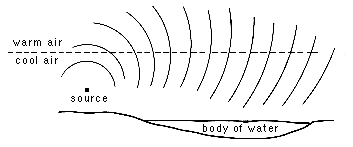The SPEED OF SOUND in air is affected by the temperature of the medium, the wave moving faster at higher temperatures and slower at cool temperatures. When parts of a SOUND WAVE are in layers of a medium at different temperatures, and therefore are travelling at different velocities, the direction of PROPAGATION of the wave changes. This effect is called refraction. A similar effect happens when the wave changes media.
For instance, when a body of warm air lies above a cooler body of air (i.e. there is a temperature inversion), the upper part of the wave, in travelling faster than the lower part, will bend forwards toward the ground (see diagram). Under such conditions sound can be heard over considerable distances.
The opposite occurs when cool air lies above warm air: here the waves are bent away from the ground, with a corresponding decrease in the distance at which the sound may be heard. For an interesting discussion of early experiments concerning these and other atmospheric effects, see Chapter 7 of John Tyndall's book Sound (1903, reprinted Greenwood Press, N.Y., 1969) and SOUND PROPAGATION.
Compare: CANYON EFFECT, DIFFRACTION, FREE FIELD, PARABOLIC REFLECTOR, REFLECTION.

Refraction of sound waves by two layers of air at different temperatures as a result of the change of speed of the sound.
home